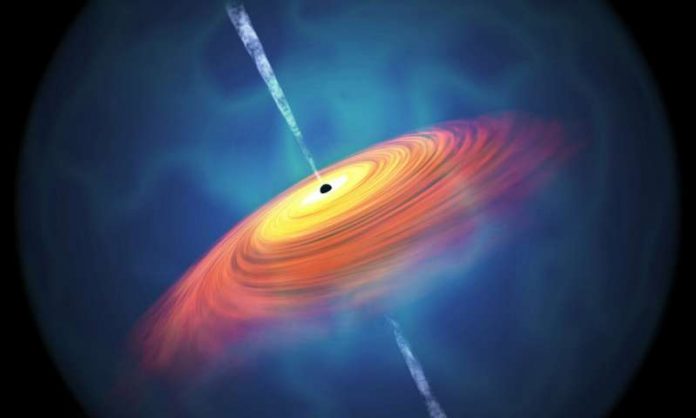Early Wednesday morning, a huge collaboration of scientists are expected to release the first images of the event horizon of a black hole, constructed from data gathered by observatories all over the globe. Combined, the telescopes created a virtual telescope as big as the Earth itself that’s powerful enough to capture enough data from the supermassive black hole at the center of our galaxy. Tomorrow, we may finally see all of that data pieced together.
Black holes, by their nature, are impossible to see with the naked eye since they are so dense that no light can escape them. Instead, any images that will be released will be the silhouette of a black hole, an outline against all of the super bright, hot gas that is thought to surround these weird celestial objects. It will be as close as we can get to a picture of a black hole’s infamous “event horizon,” the boundary of a black hole where the gravitational pull is so great that there is no escape.
It’s unclear exactly what we will see tomorrow, as the collaboration — aptly named the Event Horizon Telescope — is not releasing any details ahead of the announcement. But if all goes according to plan, these black hole images will hopefully shed some light on the nature of black holes and how they are shaped. It also could tell us more about how some black holes become millions to billions of times the mass of our Sun.
“Even though those processes are things that could happen, we have not seen any of them happening in front of our eyes to be able to understand it,” Dimitrios Psaltis, an Event Horizon Telescope project scientist at the University of Arizona, tells The Verge. “By taking a picture very, very close to the event horizon, we can now start exploring our theories of what happens when I throw matter onto a black hole.”
The Event Horizon Telescope actually observed two black holes during one week in April 2017: Sagittarius A*, the supermassive black hole at the center of our Milky Way galaxy, and M87, which is thought to be in the center of a nearby galaxy called Virgo. Both of these objects are thought to be incredibly dense. Sagittarius A*, or SgrA*, is thought to be 4 million times more massive than our Sun and 30 times larger than the star. But because it is so far away — a distance of about 26,000 light-years — the black hole appears to telescopes on Earth as though it is about the size of small ball on the surface of the Moon, according to the collaboration.
To focus in on the massive but distant objects, the Event Horizon team employed telescopes in Chile, Hawaii, Arizona, the South Pole, and other locations around the globe. Each telescope measured the radiation coming from the large swaths of gas and dust that are thought to surround black holes. These clouds of gas heat up to billions of degrees, and because the material is so hot, they emit lots of radiation, which the team could then observe from Earth. All of that data was then combined in a supercomputer to make an image that looked as if it came from a single, giant telescope. “This is a picture you would have seen if you had eyes as big as the Earth and were observing in radio,” Psaltis says.
Getting all of this data isn’t easy. In fact, the reason it’s taken so long to mount a project of this scale is that the telescopes gather so much information — about one petabyte, or a million gigabytes — of data each night of observing. It’s the largest amount of recording of any other experiment in physics or astronomy, says Psaltis. The team had to wait for hard drive technology to evolve so that it could hold the sheer amount of data that the team was collecting. “Five years ago, you couldn’t buy enough hard drives to have a terabyte of data on a telescope,” says Psaltis.
What that enormous amount of data shows could change our understanding of black holes. These objects are so dense that it’s thought that they actually leave an imprint on the surrounding space-time, warping gravity and creating strange effects on their surroundings, which scientists are still trying to understand. A picture of a black hole could tell us more about these odd happenings at the event horizon.
Results of the 2017 observations will be announced at 9AM ET on Wednesday, April 10th. If you want to watch the announcement as it happens, you can tune in to one of several live streams around the globe, including ones hosted by the National Astronomical Observatory of Japan, the European Commission, and the National Science Foundation.








